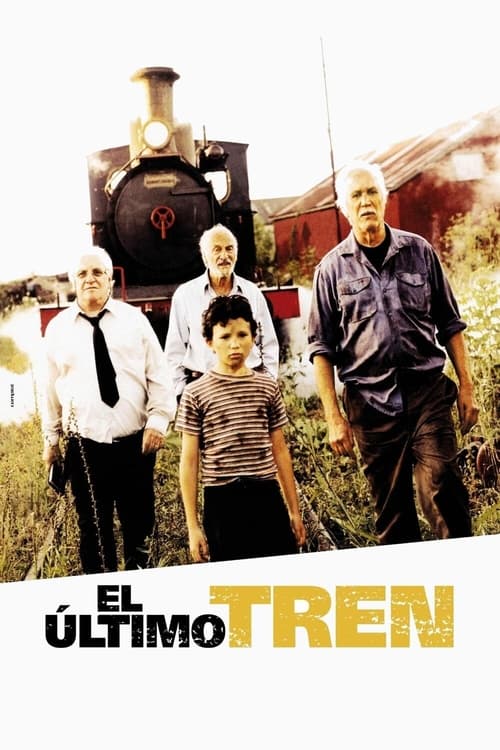
Ask Your Own Question
What is the plot?
The story of The Last Train (2002), or El último tren: Corazón de fuego, unfolds in a quiet, small town in Uruguay during the early 2000s, where the steam locomotive Train 33, affectionately called Corazón de fuego ("Heart of Fire"), sits largely forgotten but still alive in the hearts of a few devoted men. Pepe, a retired railway worker played by Federico Luppi, is the first to appear, meticulously polishing the old engine in the dusty train shed. His hands move lovingly over the metal, and he murmurs, "This train has a soul," revealing his deep emotional connection to the locomotive. Pepe is not alone in his reverence; he patiently teaches Guito, a curious nine-year-old boy and his neighbor's great-nephew, about the mechanics and spirit of the steam engine, symbolizing a passing of legacy to the next generation.
In the same town lives El Professor, portrayed by Héctor Alterio, a retired academic and intellectual who cherishes history and memory. He is often seen reading Ray Bradbury and speaking to a small group of elderly men about the importance of preserving the past. In a quiet but firm tone, he states, "Sometimes in history, violence is necessary," foreshadowing the group's eventual decision to take drastic action to save the train from being lost forever.
Dante Minetti, played by Pepe Soriano, is introduced as a man suffering from Alzheimer's disease. Despite his confusion and memory lapses, he is drawn irresistibly to the train, muttering, "The train… it's calling me." Often seen with a small, worn notebook filled with fragmented memories, Dante's struggle with his fading mind parallels the fading history embodied by the train itself.
The inciting conflict emerges when Gastón Pauls, a slick, ambitious businessman, arrives in town. He represents the outside world's cold pragmatism, eager to finalize the sale of Train 33 to a Hollywood film company. He dismisses the locomotive's sentimental and historical value, bluntly telling Pepe, "It's just a machine. It belongs in a movie, not in a museum." This confrontation crystallizes the central tension: the train's fate as a treasured piece of national heritage versus its commodification as a mere prop for foreign entertainment.
The group, calling themselves "The Friends of the Rails," is galvanized by this threat. Led by El Professor's intellectual fire and Pepe's hands-on passion, they resolve to take action. Their plan is to hijack the train and take it on a journey across Uruguay, ultimately aiming to hide it near the Brazilian border to prevent its export. Guito, the boy, accompanies them, representing hope and continuity.
Their journey begins at the small railway station where Train 33 is housed. The station is a time capsule of faded photographs, old tools, and the lingering echoes of a bygone era. The locomotive itself is almost a living character--dusty but functional, a symbol of Uruguay's industrial past and the communities it once connected.
As they set off, the landscape shifts dramatically. The train chugs through abandoned towns and deserted train stops, ghostly reminders of a forgotten time. Overgrown tracks and empty buildings evoke a melancholic beauty, and the group finds scattered letters and photographs that tell stories of people who once depended on the train. These discoveries deepen their resolve and connect them emotionally to the mission. Pepe shares a poignant revelation: he learned to drive the train during the Spanish Civil War, saying, "I've been running from war my whole life, but this train is my peace." This personal history enriches the train's symbolism as a vessel of memory and refuge.
Dante's battle with Alzheimer's is a constant undercurrent of tension. His notebook, filled with fragmented notes about the train and his past, serves as a fragile link to his identity. Though he often forgets where he is or what he is doing, the sound and presence of the train anchor him. His internal struggle is a metaphor for the collective amnesia threatening Uruguay's heritage.
Throughout their journey, the group faces non-violent confrontations. Pepe verbally clashes with Gastón Pauls, accusing him of selling out their history: "You're selling our history for a movie." El Professor confronts the authorities who try to stop their escapade, delivering a passionate speech about the necessity of preserving history and the spirit of resistance. Despite his words, the confrontation remains peaceful, underscoring the film's tone of dignified defiance rather than physical violence.
The climax unfolds near the Brazilian border, where the group plans to hide Train 33. The tension peaks as authorities arrive, intent on reclaiming the locomotive. El Professor, with quiet gravitas, reiterates, "Sometimes in history, violence is necessary," but the group consciously chooses peaceful surrender, recognizing that their symbolic act has already made an impact. They are allowed a final farewell to the train, and the authorities acknowledge the importance of preserving cultural memory, even as the train is destined for Hollywood.
The film's resolution is bittersweet. Train 33 is shipped off, but the group returns to their town, carrying the spirit of their journey with them. Pepe, Dante, and El Professor continue to share their stories with Guito, who stands on the platform in the final scene, watching the train disappear into the distance. He softly says, "The train will always be here, in our memories." The camera lingers on the abandoned towns and tracks, a visual elegy to time's passage and the enduring power of memory.
No character dies in the film; the story's drama is rooted in emotional and moral struggles rather than physical violence. The group's journey is a testament to resilience, the importance of heritage, and the passing of the torch to future generations. The film closes on a note of hope and continuity, emphasizing that while the train may leave the land, its soul remains alive in the hearts of those who remember.
What is the ending?
In the ending of "The Last Train," the survivors of the train crash face the harsh realities of their situation. As they struggle to find safety and confront their pasts, they ultimately make choices that lead to their fates. The film concludes with a sense of loss and reflection on the impact of their experiences.
As the final scenes unfold, the tension among the survivors escalates. The group, which has been through a harrowing journey, is now faced with the aftermath of their decisions. The train, a symbol of their shared ordeal, becomes a backdrop for their emotional confrontations.
In the first scene of the ending, the survivors gather around the remnants of the train, their faces etched with exhaustion and despair. They are physically and emotionally drained, each grappling with their own demons. The camera captures close-ups of their expressions, revealing the weight of their experiences.
Next, the character of Tom, who has been a reluctant leader throughout their journey, steps forward. He addresses the group, urging them to find a way to move forward. His voice trembles with a mix of determination and vulnerability, reflecting his internal struggle. The others listen, some with hope, others with skepticism. This moment highlights the theme of leadership and the burden it carries.
As the group discusses their next steps, tensions rise. Sarah, a mother figure among them, expresses her fears about the future. Her emotional plea resonates with the others, showcasing the fragility of their hope. The camera pans to the faces of the group, capturing the shared sense of uncertainty and the weight of their collective trauma.
In a pivotal moment, the character of Mark, who has been grappling with guilt over past decisions, confesses his fears. He reveals how the crash has forced him to confront his own failures. This confession serves as a turning point, allowing the group to bond over their shared vulnerabilities. The scene is charged with emotion, as the survivors begin to understand the importance of forgiveness and acceptance.
As they prepare to leave the wreckage behind, the group faces a final challenge. They must navigate through treacherous terrain, symbolizing their journey toward healing. Each character's fate becomes intertwined with their choices in this moment. Some choose to stay behind, unable to let go of their pasts, while others take a leap of faith, stepping into the unknown.
In the concluding scenes, the survivors begin to disperse. Tom, having found a sense of purpose, leads a small group toward safety. Sarah, holding her child close, decides to follow him, embodying the hope for a new beginning. Mark, having found some closure, chooses to stay behind, reflecting on his journey and the lessons learned.
The film ends with a poignant shot of the train wreckage, now silent and still. The camera lingers on the scene, emphasizing the weight of their experiences and the impact of their choices. The survivors, though separated, carry the memories of their journey with them, a testament to the resilience of the human spirit in the face of adversity.
Is there a post-credit scene?
The movie "The Last Train," produced in 2002, does not have a post-credit scene. The film concludes its narrative without any additional scenes or content after the credits roll. The story wraps up with the characters' fates and the emotional weight of their journey, leaving the audience to reflect on the events that transpired throughout the film.
How does the character of Anna evolve throughout the film?
Anna begins as a hopeful and naive young woman, but as the story progresses, she is forced to confront the harsh realities of her situation. Her character evolves from innocence to a more hardened resilience, showcasing her determination to protect her loved ones and survive against all odds.
What is the significance of the train in the story?
The train serves as a central symbol of hope and escape for the characters, representing their last chance to flee from the impending danger of the Holocaust. It becomes a physical and emotional journey for the characters, encapsulating their desperation and determination to survive.
How do the characters react to the news of the train's departure?
The characters exhibit a range of emotions upon hearing about the train's departure. Some feel a glimmer of hope, believing it to be their salvation, while others express skepticism and fear, questioning whether it is a trap. This mix of hope and despair highlights their internal struggles and the gravity of their situation.
What role does the character of the train conductor play in the story?
The train conductor is a pivotal character who embodies the moral complexities of the situation. He is torn between following orders and his own sense of humanity. His interactions with the passengers reveal his internal conflict and the broader themes of complicity and resistance during the Holocaust.
What challenges do the characters face while trying to board the train?
The characters face numerous challenges, including the chaos of the crowd, the threat of soldiers, and the emotional turmoil of leaving loved ones behind. These obstacles create a tense atmosphere, highlighting the urgency of their situation and the desperation that drives them to board the train despite the risks.
Is this family friendly?
"The Last Train," produced in 2002, is a drama that deals with heavy themes and intense situations, which may not be suitable for younger audiences or sensitive viewers. Here are some potentially objectionable or upsetting aspects:
-
Violence and Conflict: The film includes scenes of violence and conflict, which may be distressing. Characters face life-threatening situations that evoke fear and tension.
-
Death and Loss: The narrative explores themes of mortality, with characters experiencing loss and grief. This can be emotionally challenging for viewers, particularly children.
-
Emotional Turmoil: Characters undergo significant emotional struggles, including despair, hopelessness, and trauma, which may be difficult for sensitive viewers to process.
-
Survival Situations: The film portrays dire survival scenarios that can be intense and frightening, showcasing the lengths to which individuals will go to protect themselves and their loved ones.
-
Mature Themes: The overarching themes of the film include betrayal, sacrifice, and the moral dilemmas faced in extreme circumstances, which may not be easily understood by younger audiences.
Overall, while the film has a compelling narrative, its emotional weight and mature content may make it unsuitable for children or those who are sensitive to such themes.



























